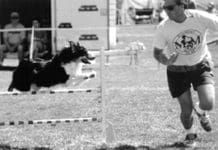Home Search
raw dog food - search results
If you're not happy with the results, please do another search
Pass It On
I'm not sure I will choose one of the energetic
What to Do If Your Dog Bites Someone
All dogs can bite, and given differing circumstances, all dogs will. Although we humans regard any bite as aggression, for dogs, biting is a natural and normal means of canine communication and defense. It's actually surprising that our dogs don't bite us more often than they do! Aggression is generally caused by stress, which can come from a variety of sources. Some dogs have high bite thresholds it takes a lot of stressors to make them bite. Some have low thresholds it doesn't take much to convince them to bite. A dog with a high bite threshold may seem like the best choice around kids. This is often true, but if noisy, active children are very stressful to the dog, even a high-threshold dog might bite them.
Regaining What Was Almost Lost
first discovered Petey at their local humane society shelter in 1990. Scheduled for euthanasia the next day
Canine Agility Training: The Ultimate Team Sport
By now, if you're into dogs, you've probably heard about agility. Maybe you've even seen it in action or tried it with your dog. Agility is one of the fastest growing dog sports in the world, and with good reason it's fun! Of all of the dog things I've done
Drinking the Purest Water Possible is Important to Your Dogs Health
Water plays a critical and complex role in the health of all mammals, constituting 55 to 75 percent of the body mass of warm-blooded creatures. A fetus develops in its mother’s amniotic sac and, from birth till death, water bathes and fills every one of a mammal’s billions of cells. In essence, the bodies of people, dogs, and other mammals are water-cooled engines. Releasing water vapor by panting and sweating through its paw pads induces gentle cooling in a dog’s body. Water also lubricates a dog’s joints and muscles, cushions the spaces between each individual cell, and fills up all of the minute hollows in a dog’s body. The principal element of blood, water transports oxygen to all canine body tissues, and helps the white blood cells produced by a dog’s immune system move about its body and fight infections.
Training Your Dog to Behave Around Guests
Whether you have a pup with normal puppy energy or an obstreperous teenager who has good manners lessons to catch up on, clicker training can be a magically effective and gentle way to convince a dog to calm down. No yelling, no physical punishment; just clicks and treats for any pause in the action. That said, the biggest challenge with a hyper" dog is that any praise or reward may cause her to begin bouncing off the walls again. It is nearly impossible to deliver a treat to an excitable dog while she is still in the act of being calm. By the time you get the treat to her mouth she is once again doing her Tasmanian devil act."
The Tools That Make Dog Training a Breeze
Blushing brides used to come to their new marriages with a hope chest and a trousseau – a collection of the basic necessities for setting up a new household. It occurred to us that dogs should come to their new homes with a trousseau, too – containing everything dog and owner need to lay the foundation for a successful lifetime relationship. We put our minds to the task, and came up with the following collection of items that should be in every dog owner’s hope chest.
Courses in Alternative Medicines
Most trainers would agree that it helps immeasurably to be very clear about what you are asking for when you work with a dog – even to the point of visualizing in your mind the behavior or movement you are seeking from your dog. Unquestionably, your focus will help you communicate your wishes to your dog, making it easier for him to interpret and understand your cues. Life is demanding and stressful for many people these days. We rarely have enough time to be as reflective as we’d like. But as you work with and care for others, including your dogs, take a moment to focus purposeful thought on your tasks.
Synchronicity
There have been cases where writing about the illnesses and issues that affect dogs have yielded positive personal results.
How to Teach Your Dog to Eliminate on Cue
and will be forced to soil the crate. Once a puppy's inborn instinct to keep his "den" clean is broken
Can Dogs Eat Garlic? Yes, in Small Quantities
One dictum for dealing with an ailing dog is to make sure he doesn’t get sick in the first place. And one way to achieve that noble end is to feed him a maintenance dose of garlic, a “wonder herb” that has a long list of beneficial effects for the dog in your life. Garlic has antiseptic, antibiotic, antifungal, and antimicrobial properties. It can be used as an anthelmintic (de-worming agent). It acts as a potent expectorant (helps bring phlegm or mucous up and out of the airway). It can lower blood pressure and prevent blood clots. And it can support the formation of good bacteria in the digestive tract.
Could Your Dog Be Breathing In Toxins in Your Home?
While we often consider our homes as sanctuaries – places of peace and safety – we may actually be living in danger zones filled with toxic airborne chemicals. Many of the building materials and housekeeping substances we use in our homes are air pollutants, capable of causing acute and long-term damage to our health, as well as the health of our dogs. We are only rarely aware of indoor air pollutants in the air we breathe – and many people are completely unaware of the potential damage that diminished air quality has on the health of every animal (including us) breathing that air.











